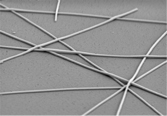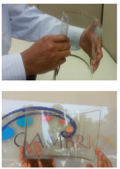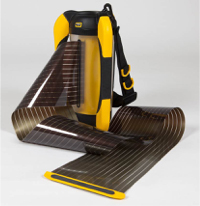



Feature Story
More feature stories by year:
2024
2023
2022
2021
2020
2019
2018
2017
2016
2015
2014
2013
2012
2011
2010
2009
2008
2007
2006
2005
2004
2003
2002
2001
2000
1999
1998
 Return to: 2015 Feature Stories
Return to: 2015 Feature Stories
CLIENT: CAMBRIOS
November 2015: OPE Journal
The broad adoption of fully-printed, film-based, flexible solar cells using silver nanowires (AgNW) for the building-integrated photovoltaics market is in full swing for a number of clear reasons. Flat and heavy are out, thin, lightweight and, most importantly, conformance to curved shapes are very much in. Building spaces previously unavailable or unusable for photovoltaic arrays can now be employed, radically improving new and/or existing buildings' capacity for meeting ever-more-stringent energy efficiency mandates. Windows, walls, support structure and architectural features of all kinds can now capture energy. A building can be virtually covered with energy capturing capabilities.

Magnified Silver Nanowires, 70 degree tiltThe two key factors allowing building-integrated photovoltaics are the flexibility inherent, in silver nanowire-based collectors and the dramatically reduced costs. Whereas fully-uninterrupted conformal coatings with sputtered TCOs make it difficult to achieve successful results, the very flexible nature of silver nanowire-based films make them exceptionally amenable as transparent electrodes in PV technologies are employed in rough thin film PV topographies.

Flex SubstrateIncredibly expanded energy production benefits result from the flexibility of silver nanowire-based PV cells. In addition to their low density, these PV panels can wrap around corners and fit the curvature of nearly any structure's contours. Silver nanowire's bending ability is unique. It is highly flexible, bendable and formable, allowing over 200,000 bending cycles down to as low as a 1 mm bending radius. This has been demonstrated with minimal change in sheet resistance. Ease of integration into formed and flexed products and roll-to-roll production are two of the cost-reduction factors making this material ever more broadly applied.
Brittle, heavy glass is out. Light, flexible PV panels using silver nanowire provide enhanced durability and allow a virtually unlimited range of applications. Flexible PV panels essentially equate to nearly limitless adaptability to buildings. Imagine unbreakable panels that flex instead of shatter when dropped or hit by hail. How about a huge PV panel array wrapped around a pillar or a building like banner lighting does? We are driving toward products like these and they are creating an increasing demand for flexible, bendable, lightweight PV cells. As more architectural designers become aware of silver nanowire PV capabilities, we will be seeing more new buildings generating their own energy.
Additionally, sheet resistance is very easily tunable from <10 up to >100 Ohm/squ and allows for easy optimization of the transparent electrode and tuning to the final PV stack, also making use of its increased transparency (BIPV, semi-transparent PV, tandem and triple PV-stacks with high AgNW electrode transparency out into the near infra-red, etc.). Lastly, the same coating material, coating technology, processing, and processing time, may be applied for a wide range of sheet resistances and levels of transparency for different PV stacks. This all helps drive production costs notably lower than traditional approaches.
Silver nanowire-based PV panels are also amenable to proven low-cost, high throughput patterning and/or direct printing techniques such as roll-to-roll stripe-coating, direct printing (gravure, etc.), wet-etching, laser-patterning and others. Some of these techniques, laser for example, also allow very high geometric fill factors (GFF), thus allowing notably better-looking PV. For example BIPV, semi-transparent PV panels compared to printed Ag-paste metal grids. They also deliver improved overall module efficiency. Lower cost, direct printing, and easy laser patterning mean that commercial laser systems may be used at higher throughput with significant production savings.
Low temperature processing and drying down to <100 C enables a wide range of possible substrates, faster production, and lower cost. Not requiring an energy wasting, high temperature process, helps to reduce the energy pay-back time. Which would make sense when manufacturing PV cells.
Some PV technologies, for example OPV and perovskite PV, require stringent encapsulation against ingress of ambient moisture or oxygen during manufacture, which entail higher costs. Due to the processing advantages of ClearOhm®, transparent AgNW electrode may be directly coated on barrier film substrates.
Mounting costs are a substantial part of the overall costs, often exceeding 15% of the total costs of the system. Clearly, using lightweight plastic substrates will allow for the use of more affordable mounting hardware with the obvious positive effect on that cost.
Moreover, owing to the outstanding mechanical properties of the silver nanowire layer, these plastic PV panels can be stretched a few percent without degradation of performance while brittle ITO electrodes fail very quickly under tensile stress. As a result, panels made with silver nanowire electrodes can respond to wind and snow load by stretching and bending without damage and do not need expensive framing and backing to provide the stiffness conventional ITO-based panels require.

Orion solar lamp by Armor
with Cambrios silver nanowires
Also of basic importance, there is no apparent limitation from a raw materials point of view. Even with a potentially high uptake of AgNW technology by one or several PV technologies with massive PV use worldwide, consumption would still only be a small amount of silver, based on worldwide production and stocks. This is very different and far more critical for relatively rare materials such as indium used in ITO transparent electrodes.
Future optimization of roll-to-roll processing of AgNW PV in conjunction with the processing of other solution-processed materials in PV stacks that have not yet been addressed will enable additional process cost reduction. For example, multi-layer coatings in one pass on roll, cascade or curtain coating, use of composite materials that combine different functionalities such as AgNW plus ETL or HTL in one layer, as well as higher speed roll-to-roll coating. There is certainly plenty of potential for production advances as demand grows.
Dr. Karl Pichler, Applications Engineering Manager; Dr. Florian Pschenitzka, Manager of Technical Marketing; Dr. Rahul Gupta, Senior Director of Business Development; Cambrios Technology Corporation, www.cambrios.com
Return to: 2015 Feature Stories